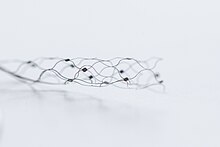
Stentrode (Stent-electrode recording array) is a small stent-mounted electrode array permanently implanted into a blood vessel in the brain, without the need for open brain surgery. It is in clinical trials as a brain–computer interface (BCI) for people with paralyzed or missing limbs,[1] who will use their neural signals or thoughts to control external devices, which currently include computer operating systems. The device may ultimately be used to control powered exoskeletons, robotic prosthesis, computers or other devices.[2]
The device was conceived by Australian neurologist Thomas Oxley and built by Australian biomedical engineer Nicholas Opie, who have been developing the medical implant since 2010, using sheep for testing. Human trials started in August 2019[3] with participants who suffer from amyotrophic lateral sclerosis, a type of motor neuron disease.[1][4] Graeme Felstead was the first person to receive the implant.[5] To date, eight patients have been implanted and are able to wirelessly control an operating system to text, email, shop and bank using direct thought through the Stentrode brain computer interface, marking the first time a brain-computer interface was implanted via the patient's blood vessels, eliminating the need for open brain surgery.
The FDA granted breakthrough designation to the device in August 2020.[6] In January 2023, researchers demonstrated that it can record brain activity from a nearby blood vessel and be used to operate a computer with no serious adverse events during the first year in all four patients.[7][8]
- ^ a b "Brain implant allows mind control of computers in first human trials". New Atlas. 5 November 2020. Retrieved 8 November 2020.
- ^ "Minimally Invasive "Stentrode" Shows Potential as Neural Interface for Brain". DARPA. 2016-02-08. Retrieved 9 February 2016.
- ^ "Stentrode with Thought-controlled Digital Switch: An Early Feasibility Study (EFS) of the Safety of the Stentrode Device in Participants with Loss of Motor Function Due to Paralysis". 29 August 2022.
- ^ Oxley, TJ; Yoo, PE (2020). "Motor neuroprosthesis implanted with neurointerventional surgery improves capacity for activities of daily living tasks in severe paralysis: first in human experience" (PDF). Journal of NeuroInterventional Surgery. 13 (2): neurintsurg-2020-016862. doi:10.1136/neurintsurg-2020-016862. PMC 7848062. PMID 33115813.
- ^ "Patients with Severe Paralysis Use Stentrode Brain-Computer Interface to Text, Email, Shop, Bank Online, First-in-human Study Reports – Neurosurgical.TV". 28 October 2020.
- ^ "Stentrode brain-computer interface receives breakthrough device designation from FDA". Neuro News. BIBA Medical. 28 August 2020. Retrieved 18 January 2021.
- ^ Lanese, Nicoletta (12 January 2023). "New 'thought-controlled' device reads brain activity through the jugular". livescience.com. Archived from the original on 16 February 2023. Retrieved 16 February 2023.
- ^ Mitchell, Peter; Lee, Sarah C. M.; Yoo, Peter E.; Morokoff, Andrew; Sharma, Rahul P.; Williams, Daryl L.; MacIsaac, Christopher; Howard, Mark E.; Irving, Lou; Vrljic, Ivan; Williams, Cameron; Bush, Steven; Balabanski, Anna H.; Drummond, Katharine J.; Desmond, Patricia; Weber, Douglas; Denison, Timothy; Mathers, Susan; O’Brien, Terence J.; Mocco, J.; Grayden, David B.; Liebeskind, David S.; Opie, Nicholas L.; Oxley, Thomas J.; Campbell, Bruce C. V. (9 January 2023). "Assessment of Safety of a Fully Implanted Endovascular Brain-Computer Interface for Severe Paralysis in 4 Patients: The Stentrode With Thought-Controlled Digital Switch (SWITCH) Study". JAMA Neurology. 80 (3): 270–278. doi:10.1001/jamaneurol.2022.4847. ISSN 2168-6149. PMC 9857731. PMID 36622685. S2CID 255545643.